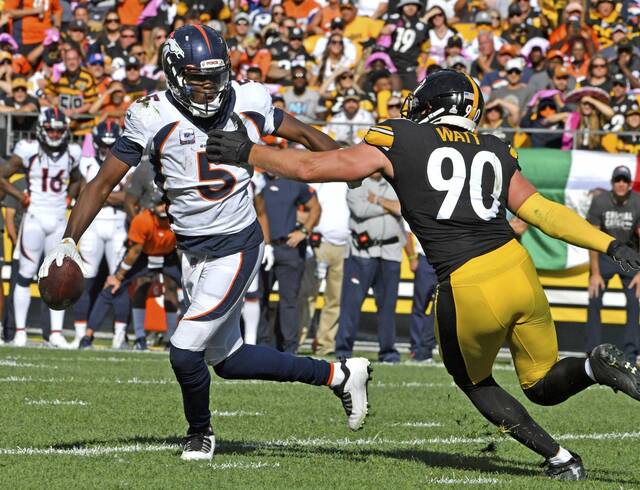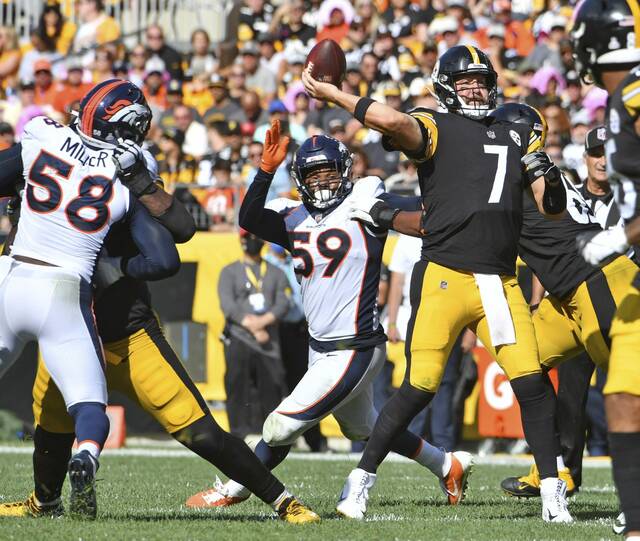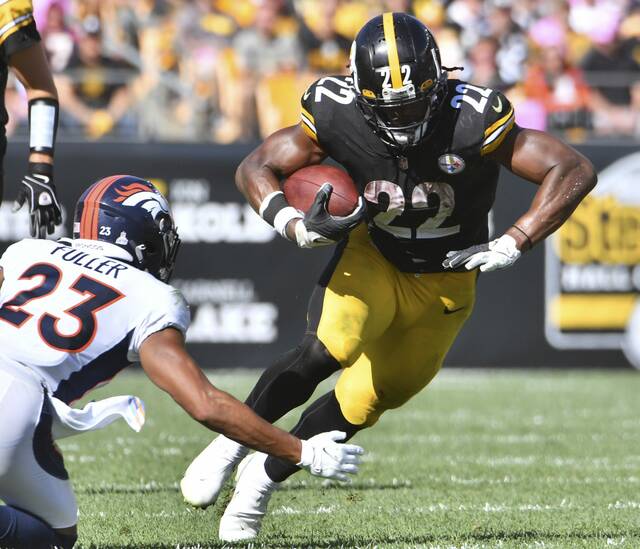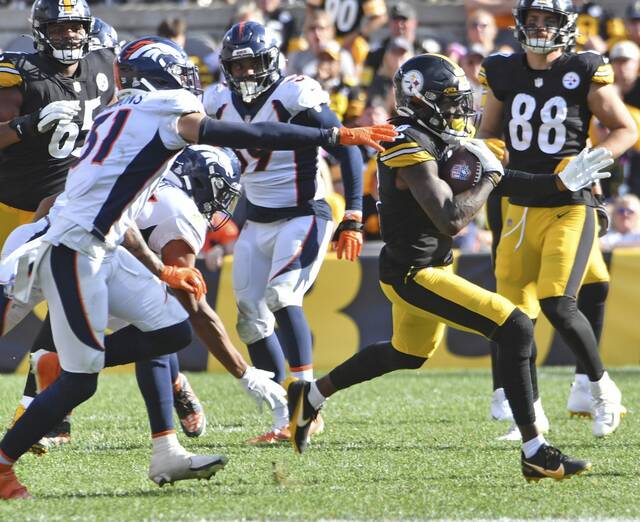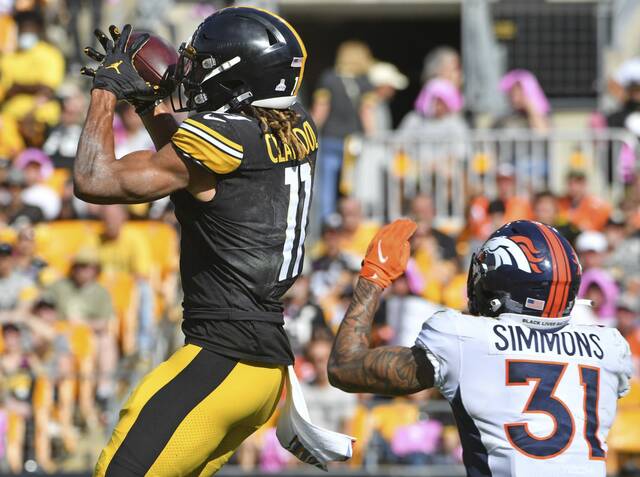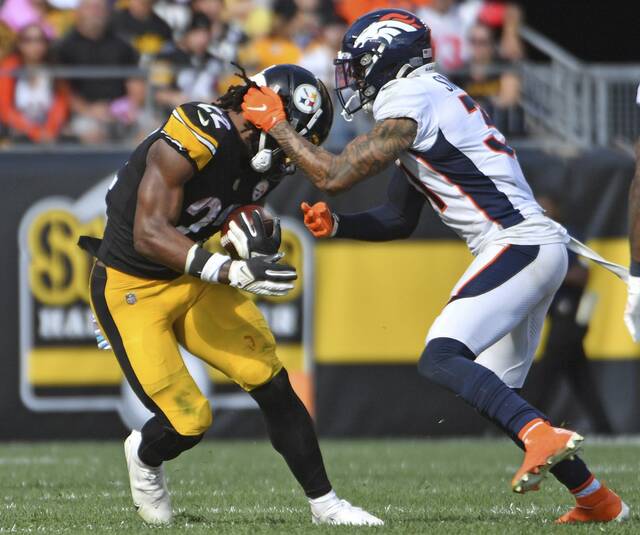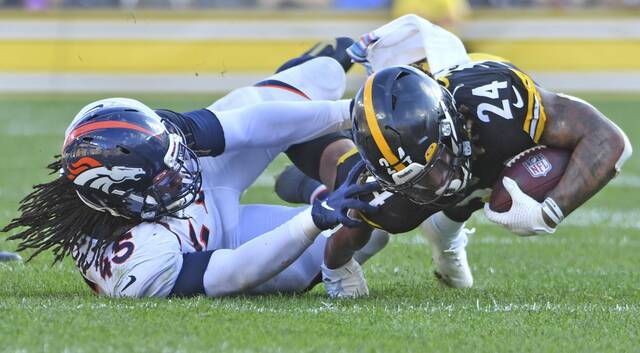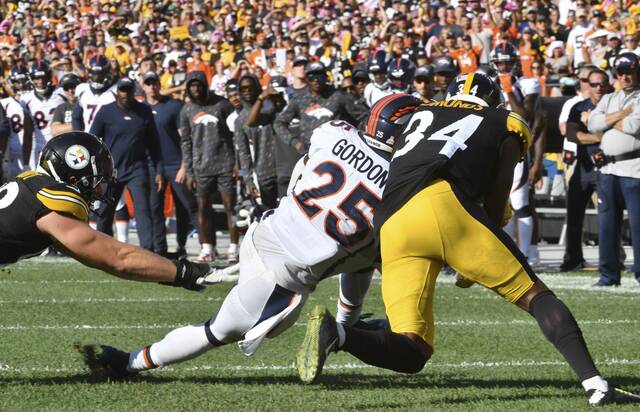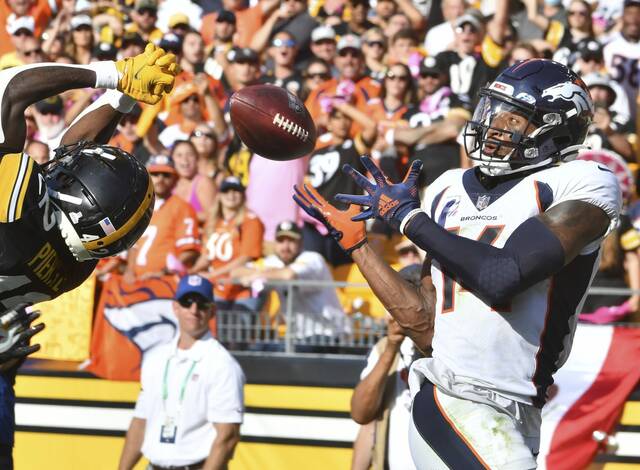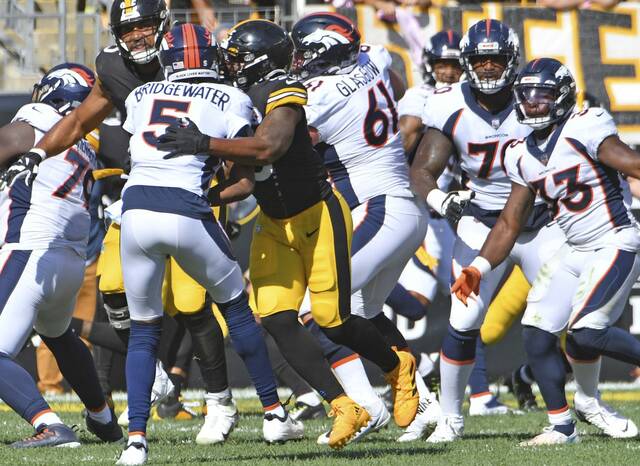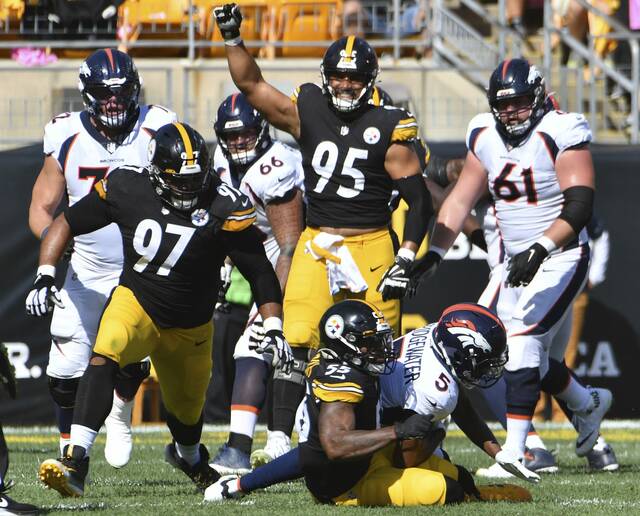Steelers Week 5 film study: Fast start key to victory over Broncos
NFL football analyst Matt Williamson will break down each of the Steelers games this season in the Trib’s Steelers Film Study. Here’s what he saw in the Steelers’ Week 5 win over the Broncos.
The 3-1 Broncos came to Heinz Field in Week 5 with Teddy Bridgewater and Courtland Sutton — two players they very much needed — both active and in top form. Denver got into an early hole on the road, one it could never get out of. But by no means were the Broncos an easy opponent for a Steelers team that desperately needed their second win of the season. And they started fast.
At the half, the Steelers led 17-6. Pittsburgh had converted 12 first downs compared to three for the Broncos. Denver was just 1 for 6 on third down. Pittsburgh had run 37 plays for 248 yards while the Broncos snapped the ball just 20 times for 107 yards.
The Steelers were averaging 6.7 yards per play to 5.4 for Denver. The Steelers possessed the football for just under 20 minutes in the first half. Quarterback Ben Roethlisberger had 165 first-half passing yards and running back Najee Harris’ 17 rushes were good for 89 first-half rushing yards.
Running back Jevonte Williams had a 49-yard run, but other than that, Denver had 14 rushing yards in the first two quarters of play. After Harris’ touchdown, Denver got the ball back with just over two minutes left in the half. At that point of the game, Denver had just 18 passing yards. This was the kind of start that the Steelers wanted, and it set the tone for the entire game.
Change of fortune
Before this week, only three NFL teams had trailed on the scoreboard for more minutes of playing time than Pittsburgh. But the Steelers never trailed in this game. Pittsburgh and Denver both averaged 6.4 yards per play in this game, and the Steelers finished the day with just 17 more yards from scrimmage than their opponent.
As mentioned, the Steelers averaged 6.4 yards per offensive play. Coming into this game, Pittsburgh’s offense was averaging just 4.9 while the Broncos’ defense was giving up just 4.6. Clearly, this is a step forward for Pittsburgh’s offense.
The Broncos were a great time of possession team during the first four weeks of the season but ran just six offensive plays in the first 17 minutes, 22 seconds. Denver didn’t get its initial first down of the game until 8:08 remained in the second quarter.
Ben back on track
Roethlisberger missed a throw here and there, but this was by far his best game of the season. The 50-yard touchdown throw to receiver Diontae Johnson’s outside shoulder with great touch on the opening series was a thing of beauty. As was his touchdown throw in the end zone to receiver Chase Claypool between three defenders.
This is something fans haven’t seen much of this year and it is encouraging. Roethlisberger finished this game with 253 passing yards, two touchdowns and zero interceptions. He did lose a fumble in the first half, and you can certainly argue that Denver could/should have intercepted Roethlisberger on two occasions.
Most encouraging though, Roethlisberger didn’t play this game frenetically. He was more comfortable in the pocket and threw the ball with touch and control. He went through his reads, and his pass protection allowed that to happen. Many more of the Steelers’ timing routes were orchestrated with the proper timing. Roethlisberger’s deep accuracy was spot on as well, and he wasn’t helped by two drops deep downfield by his receivers.
Spreading the wealth
Something you rarely see from the Steelers is Johnson getting just two targets like he did. He is almost a lock for double-digit targets in every game he plays. But Johnson was still highly effective, nonetheless, starting with his 50-yard touchdown on the first drive of the game. Of course, Denver coach Vic Fangio was aware of Johnson’s massive target track record and dedicated extra defenders Johnson’s way for much of the afternoon. That obviously helped Johnson’s teammates excel as well.
Outside of Johnson and Claypool, the Steelers’ other receivers only accounted for 51 receiving yards. Johnson played 60 snaps in this game compared to just 36 from Claypool, with Ray Ray McCloud forced to see the field for 34 snaps after JuJu Smith-Schuster was injured in the second quarter.
Claypool only ran a route on 21 plays but was targeted by Roethlisberger on six of those. Over his last three games, Claypool has 17 catches for 296 yards. Over Johnson’s last three games, he has 20 receptions for 269 yards. With Smith-Schuster set to miss time, possibly the season with a shoulder injury, Pittsburgh is in great hands with their top two receivers and probably will employ fewer three-receiver sets going forward.
Taking aim at Denver secondary
With starting cornerback Ronald Darby inactive, the Steelers picked on Denver’s Kyle Fuller with much success. Fuller also was the Broncos cover man who was called for pass interference in the end zone, which led to Harris’ short touchdown run. Fuller had a rough day.
One play to highlight though is when Claypool and Patrick Surtain battled one on one downfield. These are two extremely talented young players. Roethlisberger put the ball in a good spot for his huge receiver to make a play. Surtain broke it up well, but Claypool needs to win more contested catches considering his size, physicality and ability to get off the ground. Claypool is on the verge of greatness but consistently making plays like this could put him over the top.
First-down success
The Steelers were averaging just 3.9 yards per play on first downs. Only Chicago was worse coming into Week 5. Pittsburgh ran 26 plays on first down (not including the kneel down to finish the game) against the Broncos and averaged 3.7 yards per play.
Of those 25 plays, 20 were runs and just five were passes. The first down passes averaged 6.8 yards per play. The runs averaged 2.95. That doesn’t sound great, and, on the surface, it certainly isn’t, but Pittsburgh played with the lead for this entire game and was able to stay dedicated to running the football and creating a physical presence on first downs drive after drive.
That paid off and could really pay off going forward as this Steelers running game evolves.
Running for possession
When it was all said and done, the Steelers possessed the football for a little over 33 minutes against a Denver team that was third in that department through the first four weeks of the year. The Broncos averaged possessing the ball for 34:10 minutes of play per game.
The Steelers running game built upon what it started to show last week in Green Bay. Pittsburgh was the more physical team Sunday, and that started with the offensive line and running game.
Harris finished with 122 rushing yards against a Denver defense that hadn’t allowed a running back to gain more than 60 yards on the ground in the first four weeks of the season. While he certainly had more running room in this game, Harris continued to produce a lot of yardage after contact.
Early in the second half on Pittsburgh’s first drive of the half, Harris beat Justin Simmons, an elite NFL safety, on a quick Texas route. Few big running backs can run such sharp and precise routes in tight quarters. Harris is a superb young player who is already the foundation of Pittsburgh’s offense. Running the ball early and often paid off.
However, the dropoff from Harris to his backups is immense, and that showed up once again against the Broncos. Benny Snell and Kalen Ballage ran the ball nine times collectively and produced just 20 rushing yards — all of which came from Snell. Neither player caught a pass either.
Collectively, Snell and Ballage played 23 snaps. It is intriguing what Anthony McFarland could add in this regard when he returns from injured reserve.
Broncos’ Johnson makes impact
One Broncos defender to call out is Alexander Johnson. Johnson dropped a potential interception or two, but otherwise played a very strong game and was one of Denver’s most impactful defenders. He showed up time and time again in a positive manner for the Broncos.
Live play continues to improve
Pittsburgh’s offensive line came off the ball with good pad level and pop. They consistently moved the line of scrimmage in the run game, and Harris was able to build up some steam before first contact. They did a nice job holding up against Denver’s pass rush, often helping on the great linebacker, Von Miller.
Miller’s final stat line in this game was basically non-existent (2 tackles). The communication and attention to detail amongst these five was also the best it has been all year. That was especially apparent in picking up stunts in the passing game as well as their combination blocking for the run and getting to the second level.
The interior of Denver’s defensive line gave center Kendrick Green and guard Trai Turner problems in the run game, but, overall, this was a huge step in the right direction for this unit, especially for Dan Moore at left tackle. And this was against a quality opponent.
Tight ends get involved
The Steelers tight end usage was interesting as well, and it looks as though Eric Ebron is losing playing time. Zach Gentry is Pittsburgh’s best blocker which is earning him playing time. This was his best game as an NFL player. Gentry played 22 snaps but ran just four routes while Ebron was on the field for 25 snaps and ran a route on 15 of those opportunities. But it is Pat Freiermuth who is taking on the true “starter” role.
The Steelers got back to more presnap shifts and motions in this game. They also utilized a lot of condensed formations. That helped Roethlisberger with his reads as well as creating better blocking angles in the run game, much of which derived out of shotgun.
Stars shine on defense
Led by their stars, Pittsburgh’s defense also showed up in a big way Sunday. Cameron Heyward deflected two Bridgewater passes and continues to play with amazing passion and consistency every week. He is a force in the middle of Pittsburgh’s defensive line surrounded by a lot of backup types. This puts amazing stress on Heyward, but he rises to the occasion time and time again. And that rubs off on his teammates.
Heyward and Chris Wormley logged the majority of snaps for Pittsburgh’s defensive line, but you can’t help but wonder what this would look like with Stephon Tuitt back in the equation.
T.J. Watt showed much better lateral agility and overall explosiveness than last week. He played the run well, continually forcing the ball carrier inside to awaiting tacklers. Denver clearly game planned to stop Watt, and he saw a massive amount of blocking attention in this game. Watt played 50 of a possible 60 defensive snaps and heavily impacted this game.
The Steelers’ defense showed more looks with all three of their top outside linebackers on the field with Melvin Ingram aligned on the interior, which is something he did a lot of during his time with the Chargers. This game wasn’t Alex Highsmith’s finest performance, however.
Even with crowd noise in their favor, playing with a lead and Denver getting to the point when they were pretty much forced to throw, the Steelers pass rush never took this game over. Pittsburgh’s pass rush was fine…but only fine. It wasn’t fantastic, as should be and Bridgewater wasn’t hit enough when it was all said and done.
It must be noted though that Denver, with their quarterback quickly returning from a concussion the week before, went out of its way the entire game to help the front five in protection with running backs and tight ends routinely staying into block or chipping on their way out into their routes.
Inside linebackers stand out
Devin Bush made a big impact in this game, especially in the passing game — both as a blitzer and coverage player. However, once he left the game and didn’t return with a groin injury, Denver’s offense — maybe not coincidentally — really started to find its rhythm. Bush and Joe Schobert are jelling with one another and have become difficult to attack in the passing game in the middle of the field. Pittsburgh’s defense tackled well as a unit, led by these two.
Leaning on secondary
With Jerry Jeudy and KJ Hamler out and Courtland Sutton fighting an injury, the Steelers really trusted their cornerbacks in this game in one-on-one matchups, a strategy that paid off well early in the game. That allowed Pittsburgh to give extra attention to Noah Fant, who finished with just 20 receiving yards.
Fant and Sutton ran the same number (37) of routes on the day. Denver was forced to use Kendall Hinton as their third wide out, and while Hinton made a few plays, the Broncos would prefer he wasn’t playing 65% of their offensive snaps. No other wide receiver played more than five snaps for the Broncos.
As the game went along, Bridgewater-somewhat by necessity-started attacking Pittsburgh’s cornerbacks and that began to work in Denver’s favor. Bridgewater threw for 176 yards in the fourth quarter, but just 112 yards in the first three quarters combined.
Sutton blew up in the second half and finished his day with seven receptions for 120 yards. Patrick chipped in with seven catches for 89 yards. Sutton finished this game averaging 3.24 yards per route run, a massive number. Bridgewater threw the ball well and made good decisions while Sutton and Patrick played well and deserve a lot of credit.
Safety Minkah Fitzpatrick was all over the field racking up tackles but did miss a big one on the long run by Williams. His partner in crime, Terrell Edmunds, also greatly impacted the game as he consistently has all season. In this matchup, Edmunds gave Fant fits, and everyone saw the play he made in the end zone with the game on the line.
Another quiet, but solid, contributor in this secondary is Arthur Maulet. This was his second straight quality performance from the slot. Maulet isn’t flashy and doesn’t show up in the ways Mike Hilton did, but this is now his slot corner job and one that he rightfully earned. This secondary used a lot of bodies in this game, with cornerback Cam Sutton sidelined, to best keep everyone fresh on a hot day as well as keeping many of their key special teamers available for that phase.
James Pierre’s day was up and down and there is an argument to be made that this scheme needs to give him more help, especially in crucial situations. But he and Joe Haden made huge plays deep in their own territory when it mattered most. Bridgewater hadn’t thrown an interception this year and probably wouldn’t have if he wasn’t forced to make a play on the final play of the game (when Pierre picked him off in the end zone), but the results don’t lie. This was quite the roller coaster game for Pierre, who continues to learn.
Fourth quarter excitement
The Steelers’ defense allowed two straight touchdown drives to let the Broncos back into this game and their pass rush didn’t close this out. Denver looked to have the Steelers’ defense figured out in the fourth quarter. And in this game, you can’t blame fatigue, although it was a hot day, as Pittsburgh controlled the clock and game flow from the start.
A huge key to this game was Pittsburgh’s third down defense. Denver converted just two such opportunities on 12 attempts. The Broncos did convert 3 of 4 fourth-down chances though. Two of those conversions on fourth down kept this game interesting when it probably should have been out of reach for Denver.
Special teams moments
Special teams also played a factor in this Steelers win. Percy Harvin only had to punt twice on Sunday, but he absolutely made them count. Let’s not forget Chris Boswell, one of the NFL’s best kickers. He was dynamite once again and obviously coach Mike Tomlin has immense confidence in his kicker.
Boswell was perfect in this game and even hit a 51-yarder for good measure that doesn’t show up in the scoresheet because of a Denver penalty.
Two of Pittsburgh’s core special teams players, Justin Layne and Benny Snell, each had a penalty in the kicking game. Layne has been great on special teams this year, but his block in the back on a punt return was poor.
The Steelers started this game very hot on offense and defense. They played very good complementary football. And if Harris and Bush were available late in this game, it probably never gets to be as competitive as it was in the final moments of regulation.
Most importantly, Pittsburgh got the best performance of the year by its quarterback. This was a promising win for Tomlin’s Steelers as they gained ground in the AFC North.
Remove the ads from your TribLIVE reading experience but still support the journalists who create the content with TribLIVE Ad-Free.

